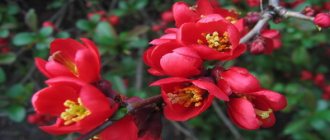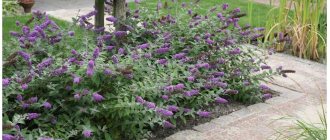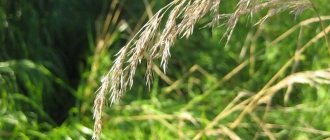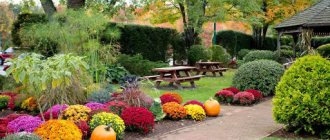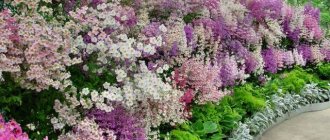It should immediately be noted that the following varieties of crops are often grown in the garden: common quince - grown as a fruit tree to produce fruits; Japanese quince (chaenomeles) - as an ornamental shrub. Specifically, this material will talk about planting common quince. Unfortunately, this southern plant will not be able to grow and bear fruit in all regions of our country. A good indicator that a fruit crop can grow in your garden: if heat-loving abris and peaches grow normally in your region, then most likely quince can too. Its popular varieties, suitable for cultivation in regions with cold winters, are: Skorospelka, Aurora, Anzherskaya, Collective, Krasnolyubskaya, Nikitinskaya, Zolotistaya, Zolotoy Shar, etc.
Description of the plant
Quince or Japanese chaenomeles (Chaenomeles japonica) is a species of perennial plants from the genus Chaenomeles of the Rosaceae family, usually deciduous shrubs. The plant comes from Japan and is grown in Europe and China.
The first Japanese chaenomeles was planted in Europe in 1796 at the Royal Botanic Gardens, Kew (UK). It was brought by Joseph Banks (1796-1820), a famous British botanist, plant hunter and director of the Royal Botanic Gardens at Kew. Seedlings of the species appeared on sale in 1870 in Great Britain.
The generic name Chaenomeles is related to the anatomy of the fetus - it comes from the Greek words:
- χαίνειν chainein (to break, open);
- μῆλον mēlon (apple).
There are 4 known species of the genus Chaenomeles, of which they are grown in our country:
- Japanese chaenomeles (Chaenomeles japonica);
- Chaenomeles speciosa – native to China and Tibet;
- Chaenomeles superb (Chaenomeles ×superba) is a hybrid of Japanese chaenomeles and beautiful.
Botanical description:
- A thorny shrub 1-2 m high.
- Escape. Young shoots are scaly, green, widely spaced, branched to the sides. Old branches are bare and turn brown. Young shoots are not leafy; on old shoots you can admire small green ovoid leaves.
- The leaves are ovate or spatulate, up to 5 cm long, sharply serrated with large, serrated stipules. The leaves fall off for the winter.
- Flowers – numerous, salmon-pink or orange-reddish with numerous stamens.
- Fruit – spherical, aromatic, edible, light yellow when ripe, sometimes with red spots. Ripen in October. They can fall or remain on the bushes all winter, providing valuable food for birds.
When grown, Chaenomeles bushes reach a height of no more than one meter, but, planted individually, they can significantly exceed these dimensions. Already in early spring, numerous flowers appear, which are most often red, but depending on the variety they can take on an orange, pink or salmon color. The aroma of flowers is not impressive, it is heavy, without a sweet note, but attracts insects.
After flowering, fruits are set, which take a very long time to ripen. After leaf fall, fruits up to 4 cm in diameter appear golden on leafless bushes, and only in late autumn are they ready for harvest. Since they do not have stalks, they look like they are glued to the shoots. The fruits are bright yellow, sometimes slightly speckled, hard, shaped like small apples, and very sour in taste. They are characterized by an intense aroma that spreads very quickly throughout the room in which they are stored.
The plant is not self-fertile. The flowers are pollinated by pollen of other types of quince (fine, Japanese, excellent). In practice, it is not always necessary to plant 2 different varieties in the garden. It is enough if your neighbor grows quince.
Due to its flowering time, quince is an ideal honey plant. Flowers provide nectar and large amounts of pollen, stimulating the intensive development of bee colonies.
Pests
Chaenomeles japonica is rarely attacked by pests, only when completely neglected by the owner. The number of insect pests that pose a danger to shrubs is small:
- Aphids damage young shoots and leaves. The bush is treated with an anti-aphid agent, using a folk remedy - an infusion of onion peels.
- The scale insect sucks the juices from the plant, slowing down its development. If the branch is slightly covered with plaques, the pest is removed mechanically; if the attack is severe, it is sprayed with Aktara or karbofos.
- Spider mites appear during dry times. They get rid of it by wiping it manually or using herbicides.
The best protection for a plant is preventive work and compliance with care requirements.
Interesting varieties
- "RedJoy" Red Joy is a thorny deciduous shrub that grows up to 50 cm. The leaves are small and shiny. The flowers are large, 3 cm in diameter, red, fragrant, appear in March-April, before the leaves develop. Red Joy fruits are edible, yellow, aromatic. Chaenomeles loves sunny or slightly shaded places and moist soil. Suitable as an original decoration for small gardens, for planting in public places, and for constructing low hedges.
- “Sargenta” Sargentii - the variety has a wide crown, reaching 1.5 m in width and 0.8 m in height. Before small leaves appear, bright orange flowers will bloom on the thorny bush in March-April. It bears fruit in the fall; large greenish-yellow fruits with a red blush are used in jelly, for making tinctures and wine.
- "Sido" Cido - the shrub produces bright yellow fruits containing vitamin C and pectin. Fruits are used to make wine, delicious liqueurs, and jellies. The "Sido" variety grows up to 1 m in height and 2 m in width. Growing requirements: a warm, sunny position with a moderately moist substrate. Care consists of trimming lush side shoots.
- «Calif" - a variety bred in the Donbass. Can reach a height of 2 meters, non-thorny. The flowers are white with pink spots. Fruits weigh about 100 g. Resistant to frost, drought, and pest damage.
Crown formation
In early spring, it is recommended to carry out the main pruning of the quince, before sap flow has yet begun. Disease-affected and dry shoots must be removed and burned.
Spring pruning of quince
Pruning rules
Once the tree has formed, its crown should look like a bowl with an open center . You need to leave 5 skeletal branches, which are located at a distance of 15 cm from each other.
Low-growing varieties should be given a sparsely tiered crown , which will include 8-9 shoots. The branches should be uniform.
The standard must be formed at a distance of 40 cm from the soil surface.
Spring pruning When planting a seedling in a permanent place, you must immediately prune it to a height of 50 cm, leaving only 6-7 buds on the plant. The lower tier will subsequently be formed from them.
A year later, also in early spring, you need to carry out 1 more pruning. Now you need to shorten the central branch by 30 cm. Last year's growth is shortened to 50 cm.
Side shoots should not be trimmed. They should be removed only if they thicken the crown and prevent other branches from growing.
It is recommended to remove all root shoots in a timely manner. By 3-4 years of age, the crown should be formed.
Autumn pruning Starting from the age of 5, pruning should be supportive. All excess should be cut out in the spring.
Sanitary pruning is carried out in the fall, after the leaves have fallen. At this time, all dried, thickening and diseased branches are removed.
Growing conditions
Quince is very easy to grow and has extremely small requirements.
The preferred soil for quince is as follows:
- fertile;
- moderately humid;
- the reaction is preferably neutral (pH 6-7);
- prefers heavy soils.
The bushes can cope with conditions in almost any location. They do not like saline and swampy soils. They do not tolerate areas where water remains for a long time during the growing season. The shrub reacts to stagnant water with a significant reduction in growth and disease.
On alkaline and dry soils, quince is susceptible to chlorosis associated with poor absorption of iron. Then acidification with sulfur or iron sulfate is recommended, but it is more effective to apply iron chelates to the soil or in the form of foliar feeding “on the leaf.”
For intensive flowering and fruiting, you need to provide good access to sunlight. The plant loves the sun, so it should not be placed on the north side of buildings or under tree canopies. Shrubs growing in the shade are sparse, poorly leafed, and produce few flowers.
The plant grows best in warm regions where the risk of frost is low. Quince should be given a warm, protected place. A shrub grown in good conditions produces a good harvest with excellent taste.
Is the area suitable for a tree?
Japanese quince (Chaenomeles japonica) is a deciduous shrub. The height of the plant does not exceed 3 m. Unlike quince, chamenoles has completely different characteristics and has higher frost resistance. This ornamental shrub can withstand temperatures down to -30 degrees . And if the branches freeze, quickly recover.
Thanks to this feature, the distribution area of Japanese quince has expanded significantly. The crop began to be grown in European countries with a temperate climate, as well as in the central region of Russia, including the Moscow region. But the first three years after planting, the shrub needs to be insulated for the winter.
At the initial stage of growth, Japanese quince requires increased attention from the gardener so that adaptation to new conditions occurs more quickly.
Landing
When to plant quince? Bare-root seedlings should only be planted when the plants are dormant:
- autumn: October – December,
- spring: March – April.
Compliance with these deadlines will give the best survival of plants in a new place.
You need to ensure that the substrate is slightly moist and free of weeds. Before planting, you need to prepare the site - dig up, select weeds, add compost. The hole for the seedling should be 30-40 centimeters deep.
Seedlings with a closed root system (in containers) can be planted at any time except winter
Bushes are planted at a distance of 2.5-3.5 m from each other (row spacing) at 0.75-1.5 m in a row. The best effect is obtained by planting Japanese quince in rows, at a distance of 1 meter, if we want to get the effect of a continuous low hedge.
A freshly planted bush should be watered abundantly.
Selecting a seedling and location
A seedling aged 1-2 years is selected for planting. The root system can be either open or closed, but in those older than one year it is usually closed. If the roots are open, then it is easier to assess their condition than in a clod of earth or in a pot.
What to pay attention to:
- kidney condition - healthy, dense;
- there should be 3-4 fully formed buds at the base of the shoot;
- the condition of the roots and bark is without dry areas or damage, the root cut is light, the bark is dense and elastic.
Related article:
Autumn feeding of apple and pear trees for wintering and harvest
The location for the future tree is chosen in a sunny area, since the crop is thermophilic and requires a large amount of solar energy for development. Nearby buildings and tall trees will shade the young plant, which will affect the development and quality of fruiting. An open place, protected from cold winds by a slope, hedge, or fence (no closer than two meters), is best suited.
When planting, take into account that the crown of an adult tree grows several meters, and the roots occupy an area of about 6-8 meters in diameter. Therefore, any other large plants are placed at a distance of 5 m or further, and small shade-tolerant crops, the roots of which will not harm the tree, are planted in the tree trunk circle. Otherwise, the plants will not have enough nutrients.
The root system is located in shallow horizontal layers, so high groundwater levels will not harm them. The main thing is that the water does not stagnate.
Growing and care
Japanese quince is considered an undemanding shrub. It grows well without special care and can even withstand drought. However, care should not be neglected completely. The shrub does not tolerate weed competition well, especially at a young age, so you need to regularly remove them and mulch the soil.
Watering
There is no need to water frequently. During drought, young bushes can be watered once every 2-3 days to support their growth. Moderate humidity of the substrate should be maintained; adult plants will survive the dry period without problems. But the shrub blooms and bears fruit more profusely when the soil does not dry out too much.
The earth should be mulched with bark so that it does not quickly lose moisture and does not become clogged with weeds.
Feeding
It is worth feeding the quince with rotted compost annually or once every 2 years, and the young bushes with nitrogen fertilizers in the spring.
Autumn care, preparation for winter
Planting and caring for quince in the Moscow region will be easy, just carefully cover its branches from frosty gusts of wind; in the spring there is no need to fear unpleasant surprises. Japanese quince grows in Siberia and the Urals and is one of the most frost-resistant shrubs. However, in Siberia it can bloom only on the lower branches, so summer residents form the bush so that the branches are closer to the ground. For the conditions of Siberia, the low-growing varieties Nikolina and Jet Trail are better suited. During winter, it is worth properly covering its roots with agrofibre or bark.
During severe winters, branches not covered with snow may freeze, but after pruning the bushes usually grow back.
Trimming
One of the most important maintenance methods when growing Chaenomeles japonica is pruning. Immediately after planting, we shorten all the branches to stimulate the bush to develop, speed up acclimatization in a new place, and control the shape of the plant from the very beginning.
The next pruning of quince is carried out in the spring, in March. Weakened, overgrown shoots are completely cut off. It is necessary to regularly trim stems that are too long and shoots that do not bear fruit. It is recommended to cut them in half. It is also necessary to remove old branches and those parts of the plant that overly compact the bush or are affected by disease.
Diseases and pests
Quince is relatively resistant to diseases and pests in our climate. However, in unsuitable conditions it can hurt. The most common diseases are the following:
- Moniliosis of fruit crops - brown, fast-growing spots of rot appear on infected fruits, and on them are characteristic concentric beige-gray warts on which conidial spores form. The rotten fruit dries up and remains on the tree in the form of a brown-black mummy until next spring. It is necessary to spray 2-3 times, starting from the June fall of the ovaries, with copper oxychloride (the drug Hom) or another copper-containing fungicide.
- Powdery mildew - a white powdery coating appears on the entire surface of tissues developing from infected buds. Severe infection of leaves inhibits their growth, then leads to deformation and drying out. The fruits have a white powdery coating, which later turns into a reticulated browning. Effective drugs: Topsin M 500 SK.
- Pear scab – the first symptoms appear as olive-green, velvety, uneven spots. Then the spots become dark brown, black with clear edges. Heavily infected leaves curl, wrinkle, and the spots on them merge into large clusters, often located along the main vein. As the fruit grows, the spots become dark brown and corky. The first spraying should be carried out in March with Hom. Effective drugs for treatment are also: Evaziol, Lecitek, Medzian Extra 350 SK, Poliram 70 WG.
- Bacterial canker of fruit trees - in early spring, irregularly shaped spots appear on the trunk, branches, and young shoots. Sometimes characteristic cracks are observed in the upper layer of the bark. Frostbites contribute to the development of the disease. During leaf fall, spray with the following preparations: Miedzian Extra 350 SC, Miedzian 50 WP.
- Bacterial burn of fruit crops - the affected flowers are at first as if saturated with water, then quickly wither, shrivel, and die. Young green shoots wither on top, turn brown over time, and die. Dark green spots appear on the fruit buds, which then turn red-brown. Rotting appears on the branches and trunk. At the site of infection, the bark collapses and dries out. Spraying: Hom, Topsin M 500 SC at the stage from bud swelling to flowering and during the growth of fruit buds.
The most common pests of quince:
- Aphids - when they appear, the leaves and shoots curl. The pest produces a large amount of honeydew, which infects shoots and fruits. Immediately after the first symptoms appear, fight with the following drugs: Karate Zeon, MKS.
- Fruit spider mite - during the growing season, small light spots first appear on the leaves, which merge into large spots. Damaged leaves turn brown, dry out, and fall off. The fruit does not grow and does not color. Flower buds set worse the next year. Carry out 2 treatments (before flowering and in early June) with Karate Zeon, MKS or another drug with an acaricidal effect.
Care at different times of the year
With the arrival of spring, before sap flow has yet begun, it is necessary to carry out sanitary pruning: remove shoots broken under the weight of snow, dried branches and those affected by diseases. Young specimens need formative pruning, old ones need rejuvenating pruning.
Blooming tree
When the buds begin to bloom, the quince is treated with 3% Bordeaux mixture.
If the moment is missed and the kidneys have opened, you cannot treat with Bordeaux mixture, as it will only do harm.
In the spring, the trunks are whitened with lime, and mineral fertilizers are added to the soil. During the budding period, treatment for pests is necessary: aphids, moths, sawflies, leaf rollers, and moths. Quince often suffers from powdery mildew, so treatment with Fastak only brings benefits. You will need to dissolve 3 ml of the product in 10 liters of water.
During the period of budding, flowering, and after it, trees are provided with abundant watering. Mineral fertilizers are added to the soil.
When the plant fades, after 10 days preventive treatment against pests and diseases is carried out again. You can use Topaz or its analogues.
In early June, insecticide treatment is carried out. We must not allow codling moths, moths, aphids, leaf rollers, and goldtails to appear on trees. For treatment, you can use the following solution: dissolve 6 ml of the Sonet preparation in 10 liters of water.
During the entire growing season in the summer, you should not get carried away with chemical treatments. They should be carried out only as needed.
In the summer you need to weed the tree trunk and remove weeds. To avoid unnecessary work, you can mulch the ground around the trunk.
In July, complex mineral fertilizer is applied under the trunk. A month before harvest, all fertilizing must be stopped. After harvesting, the plantings are treated with a 5% urea solution.
In autumn, moisture-recharging irrigation is recommended. During the dormant period, when the plant sheds its leaves, it will be necessary to carry out thinning, sanitary and rejuvenating pruning.
Reproduction
There are 3 ways to obtain young Japanese quince seedlings:
- seeds,
- cuttings,
- root suckers.
Seeds
The most difficult way to propagate quince is by sowing seeds. You can sow seeds in pots all year round.
For good germination, the seeds need preparation - you need to soak them in water for 24 hours and stratify (cool) in the refrigerator for 60 days at a temperature of 5 °C.
Seeds for stratification are placed in a substrate prepared from clean, wet sand or sand mixed with peat in a 1:1 ratio. The ratio of seeds to substrate is 1:3, they are mixed so that individual seeds have less contact with each other. The mixture of seeds and substrate is placed in plastic containers or ziploc bags. Every 2 weeks and in the last month of stratification, the contents of the container should be stirred, ventilated, and, if necessary, moistened. After the first shoots appear, stratification stops and the seeds are sown in pots or open ground.
Further actions depend on the time of year:
- in spring we sow directly into the ground;
- in the fall - the seeds are sown in containers and only in the spring the seedlings are transplanted into open ground.
Seedlings are sown in pots with regular garden soil, placed in a warm place, and protected from drying out. The resulting seedlings do not exactly inherit the characteristics of the mother plant; if maintaining the variety is important, then the seedlings are then grafted using the budding method.
Cuttings
Most often, quince is propagated by cuttings. Half-ripe cuttings are used. The shoots are cut at the end of June - beginning of July. Young shoots of this year are chosen. Immediately after cutting, they are dipped in a preparation that stimulates the formation of roots and planted in loose, moist soil. After a few weeks, roots of the right size should appear to allow the plants to be transplanted to their destination.
Root suckers
Old specimens tend to grow laterally with the help of root suckers. Usually the shoots are cut with pruning shears (preferably underground).
The easiest way of propagation is to cut off the offspring from the mother bush, which often appear when growing quince. You can immediately plant them in the chosen place in open ground.
When to plant quince in spring: optimal timing
In order for planting to be as successful as possible (i.e., the seedling takes root faster and adapts without unnecessary stress), it is necessary to observe the optimal timing of the spring procedure. When is it better to plant fruit crops in open ground? This should be done before the buds swell , and also after the outside temperature begins to remain stably above +4-5°C.
It is impossible to name an exact universal time for completing the procedure for each region. After all, weather and climate conditions vary greatly. For example, in the middle zone (Moscow region) planting is optimal in mid-April, but in Siberia and the Urals it is better to do this at the end of April, while in the southern regions this can be done much earlier: at the end of March.
By the way! When choosing planting dates, you can use the 2022 Lunar calendar:
- Favorable days: in March: 5, 6, 10, 11, 20, 21, 24, 25, 29, 30;
- in April: 9, 10, 15-17.
- Unfavorable days: in March: 12, 28;
- in April: 11, 26.
Application
Japanese quince was grown in our country decades ago. The bush attracts attention mainly in March-April, when flowers with unusually beautiful petals appear on thorny branches. There are many options for its use in many areas of life: gardening, landscape architecture, culinary arts, natural medicine, cosmetology.
Ornamental plant
Since quince blooms very abundantly and the flowers are brightly colored, the bush can be successfully grown to decorate gardens, roads and busy streets, where growing conditions are quite harsh. It beautifully decorates parks, classic and rocky gardens, terraces or balconies.
Quince bushes compact easily; when planted side by side, they form a compact structure. Proper formation will allow you to get a very interesting effect of a hedge, which is showered with flowers in early spring, and yellow fruits in the fall. Quince hedges decorate gardens and effectively protect against uninvited guests with thorns and dense branches. Even heavily pruned bushes bloom and bear fruit on old branches.
Tall, long, dramatic hedges can be created by combining quince with forsythia, ligustrum or barberry. Low-growing varieties are usually planted in uniform rows, for example, along alleys. On a meter-long plot you need to plant 3-5 bushes, depending on their growth vigor.
Ornamental Japanese chaenomeles is planted on slopes; it strengthens the soil well thanks to its very deep roots. Therefore, the bush is difficult to remove from the site.
You can even grow quince as bonsai - miniature trees that bloom in the second year of cultivation.
When does it ripen and how to collect it?
The fruits ripen in September or October, depending on weather conditions and quality of care. Their peel is covered with a dense layer of waxy coating, which protects the quince from damage by pests. If the fruits are not yet ripe, they still need to be collected before frost sets in. If you place them in a room where the air temperature is from +3°C to +5°, then they will be able to ripen. Japanese quince fruits need to be collected in tight boxes and laid out so that they do not hit each other. Otherwise, the crop will not be stored for long and will very soon begin to rot.
Pros and cons of growing near Moscow in open ground
Growing this shrub in the Moscow region has its pros and cons. And before planting Japanese quince on your site, you need to familiarize yourself with them.
Main advantages:
unpretentiousness;- compactness;
- versatility of crop application;
- abundant early flowering;
- high life potential;
- decorative throughout the season;
- compatibility with other cultures;
- resistance to diseases and pests.
Flaws:
- annual growth no more than 8 cm;
- intolerance to stagnation of moisture;
- susceptibility to return frosts;
- increased lighting requirements.
The fruits of Hemenoles exude a pleasant rich aroma.
Main varieties and types of quince
Common varieties and types:
- Common quince. Height up to 3 m. Blooms in May, ripens in October. Not afraid of drought and frost.
- Ordinary golden. Pleases with large fruits (up to 400 g), ripening in September. Up to 60 kg of fruits are obtained from one plant.
- Muscat fruitful. Fruits weighing up to 500 g. Thanks to the juicy pulp, the fruits can be eaten raw. Up to 100 kg of harvest is obtained from one tree. The plant is resistant to weather conditions and is not susceptible to fungal diseases.
- Lemon Volgogradskaya. Quince is resistant to drought and frost. Grows in the form of a bush. The fruits are aromatic, sweet and sour.
- Pink Lady. A thorny shrub with a wide crown. It looks beautiful during the flowering period, covered with soft pink buds.
Breeders continue to develop new varieties, increasing the crop's resistance to frost and drought. The chosen quince variety will determine how to grow and care for the tree in order to get a good harvest.
Breeding with seeds
Sowing quince from seed takes a little time, but if you follow the rules and persevere, you can soon have hardy seedlings ready for planting.
Selection of planting material
In order to germinate seeds yourself at home, you need to choose the right planting material. The best way to collect seeds is to remove the most beautiful fruits from the tree. The fruits should be large, without signs of rotting, disease or pest damage. To get the seeds, cut the fruit and carefully hollow out the planting material.
The seeds are placed on newspaper and allowed to dry in the sun during the day. Dried seeds are visually checked for chips, damage and contamination.
Germination from seed
How to grow quince seeds at home to obtain healthy sprouts: just stratify the planting material. Stratification is a process of natural selection to which seeds germinate under natural conditions are subjected. A cool, moist atmosphere must be created at home for quince seeds to germinate.
First, soak all the seeds in water at room temperature for about 4 days and do not allow the liquid to stagnate. The water must be changed every 12 hours. Then begin the stratification process.
- Prepare a container for the sprouting material - this could be a sealed bag or pot that will require cling film to keep the container sealed.
- Choose a substrate in which the seeds will be stored for 2-3 months: small wood chips, soil, coarse sand.
- Moisten the soil with a sprayer; 2-3 sprays are enough.
- To prevent the formation of mold spores, the fungicide Oxyquinoline is applied to the substrate along with the seeds.
